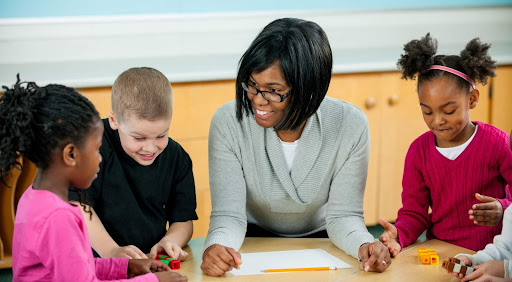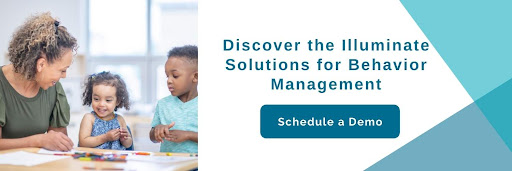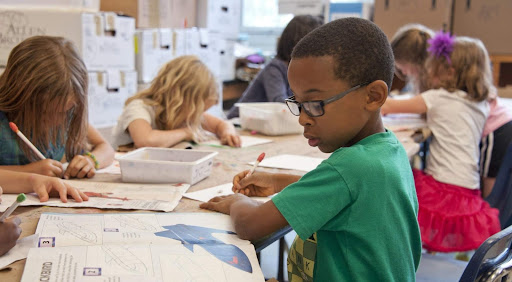Prevention: The Key to Managing Student Behavior
It’s not hard to imagine that most teachers enter the education field because of a love for students and a love of learning.
But all too often, student behavior, and correcting student behavior, can seem to derail a teacher’s best efforts at doing the thing they love — teaching their students.
What if we could turn the question …
“How do you manage student behavior in the classroom?”
… to, “Is it possible to prevent student behavior issues in the classroom?”
We’ll answer both of these
Table of Contents
- Why Is Prevention So Important in Classroom Behavior Management?
- Preventing Issues Related to Behavior: Classroom Management Strategies
- Know What to Avoid
- Establish a Productive Learning Environment
- Create Opportunities for More Frequent Positive Feedback
- Address Problem Behavior Immediately
- 2 Tips on How to Manage Student Behavior Using the Above Strategies
- #1: Utilize Effective Behavior Prevention Resources
- #2: Know What Your Students Experience at School and at Home
- Learn More About Effectively Managing Student Behavior With Tools From Illuminate Education
Why Is Prevention So Important in Classroom Behavior Management?
“An ounce of prevention is worth a pound of cure.”
When Benjamin Franklin coined this phrase in 1736, he wasn’t speaking about behavior tips for teachers, but the phrase still holds true in the 21st-century educational system when it comes to managing student behavior.
Just like eating right and exercising pay big health dividends in the long run, doing the hard work of prevention on the front end of classroom management can keep problems from popping up that later need to be fixed.
True — preventing problems requires time and resources — but the alternative can be even more costly.
Merely responding to challenging student behavior with consequences may seem like the easy way out, but preventing those negative behaviors in the first place means students can remain in the classroom, learning and engaging with their peers.

Preventing Issues Related to Behavior: Classroom Management Strategies
Educators are convinced that prevention is preferable, but many teachers have tried different classroom management tactics without success.
Rather than plodding through with an approach that isn’t working, take a look at these behavior strategies for students geared at preventing unfavorable student behaviors before they start.
Know What to Avoid
Sometimes the best way to know how to approach an issue is to first identify actions to steer clear of. So take care to avoid the following:
-
- Power struggles rarely if ever, produce the desired behavior from your students. Rather than resolving the problem, power struggles are likely to escalate them. When you feel the temptation to engage in a power struggle:
- Take a step back
- Remain calm; and
- Keep the conversation short and succinct
- Requiring students to remain stationary for long periods is a sure way to invite unruly classroom behavior. According to a 2013 study of six California elementary schools, “Implementing classroom physical activity breaks can improve student physical activity during school and behavior in the classroom.”
- Power struggles rarely if ever, produce the desired behavior from your students. Rather than resolving the problem, power struggles are likely to escalate them. When you feel the temptation to engage in a power struggle:
Public reprimands, especially in front of their peers, are another thing to avoid. No doubt, there will be times when students need to be corrected. When those times come, pull the student aside or step outside the room to privately address the inappropriate behavior.
Establish a Productive Learning Environment
The learning environment can be either a make-it or break-it scenario. Even as adults, we understand the difficulty of attempting to work or study in less-than-stellar surroundings.
For children, the classroom environment can be key to their learning and behavior.
Teachers should pay careful attention to the following to create an environment ripe for learning and classroom behavior management:
-
- Consider the seating arrangement:
- Is the student facing the teacher?
- Does the seating arrangement invite unnecessary interaction with other students?
- Be sensitive to noise:
- Is the air conditioning unit outside making a distracting noise?
- Is the hubbub in the hallway making it difficult for a student to focus?
- Keep the student close to the teacher. Students who struggle with behavior issues can benefit from staying in close proximity to the teacher.
- Consider the seating arrangement:
Remove temptation by distancing students struggling with behavior issues from others who may be instigators.
Create Opportunities for More Frequent Positive Feedback
We all seem to have a natural tendency to focus on the negative. But making a small and decisive change in this area can result in favorable dividends when it comes to a peaceful and enjoyable classroom.
Make it a goal to provide more positive feedback than negative. A good ratio to strive for is 4:1 — four positive comments for every one correction.
Not only will classroom behavior improve, but the student/teacher relationship will have more of a chance to thrive.
Address Problem Behavior Immediately
We know that a classroom is a busy place.
Teachers perform a variety of activities throughout the day, including but not limited to:
-
- Teaching lessons
- Reading books
- Keeping records; and
- Managing behavior
During overwhelming moments, it can be hard to prioritize correcting behavior. And though that may seem the best option at the moment to finish the lesson, addressing problem behavior right away is a huge step teachers can make to prevent more troubling student behavior later on.
Addressing students one-on-one in a supportive manner …
-
- Provides students with immediate feedback
- Keeps the situation at the forefront; and
- Helps the student know how they can improve
… and, in the end, helps restore and improve the relationship between the student and teacher.

Two Tips on How to Manage Student Behavior Using the Above Strategies
Most teachers and school administrators agree that preventing issues that lead to negative student behaviors is more desirable than the alternative. But many struggle to find a way to manage classroom behavior in a way that results in happy and fulfilled students and teachers.
Knowing what to do and having the resources and ideas to correctly address behavior can feel insurmountable, but having a comprehensive assessment solution that helps identify or address the underlying motivations behind challenging behavior can help.
Illuminate Education offers resources to equip educators to know how to best manage student behavior and establish best practices through:
- Screening and process monitoring assessments
- Social-emotional assessment and progress monitoring
- Dyslexia screening
- Reports and data visualization
- And more
… Illuminate Education strives to equip educators with the best tools to measure student progress and determine the most effective instructional or intervention strategies.
#1: Utilize Effective Behavior Prevention Resources
While behavior prevention resources abound, we recommend this free Behavioral Intervention Guide from The Vermont-National Education Association (VNEA).
With this guide, you’ll be equipped to practice various approaches to measuring social-emotional behavior (SEB) skills, including:
-
- Elements of an integrated SEL (social and emotional learning) program
- Approaches to measuring SEL
- Descriptions of behavior interventions; and
- Prevention strategies
Learn How to Make Simple Adjustments
What if behavior intervention and management were approached in a way that didn’t feel overwhelming and could be implemented by a classroom teacher?
That’s what the Behavior Intervention Guide does. It shows teachers how to make simple adjustments that can result in positive changes for the entire classroom.
These straightforward changes:
-
-
- Support student behavior prevention
- Increase appropriate behavior
- Decrease inappropriate behavior; and
- Provide strategies for effective behavior management
-
Learn New Ways to Provide Structure
In addition to simple adjustments, teachers can benefit from making changes in how they structure their classroom’s day.
Two ideas for structure changes include:
-
-
- Daily routine; and
- Non-instructional periods
-
Students thrive on routine, and conversely, not knowing what to expect from day to day can leave students in an uncomfortable and apprehensive state of mind.
Teachers who find creative ways to structure their routines without creating monotony can make the learning environment more inviting and have fewer disruptions and behavior issues.
The school day is more than just instructional time, so adding some structure to the non-instructional parts of the day adds to student expectations and enjoyment.
This guide can provide creative ideas to recreate structure to non-teaching segments, such as:
-
-
- Recess
- Lunch
- Library time
- Walking through the hallways
- Taking attendance
- And more
-
Learn How to Utilize Interventions During Remote Learning
These tips can be useful for preventing behavior issues in students who are involved in remote learning:
-
-
- Provide opportunities for students to take breaks
- Give alternate methods for students to ask for help
- Set clear expectations
- Praise appropriate behavior; and
- Give students ample opportunities to respond
-
#2: Know What Your Students Experience at School and at Home
Without a doubt, teachers understand the importance of knowing their students.
Knowing students well allows teachers to:
-
- Accentuate students’ strengths
- Understand student struggles and weaknesses; and
- Adjust the learning style to fit students’ needs
But beyond academic success, knowing your students personally helps to foster a strong student/teacher relationship that is based on:
-
- Understanding
- Compassion; and
- Respect
Knowing what students experience both at school and home can give a teacher valuable information regarding student behavior.
It can not only help a teacher understand why a student is behaving in a certain way, but it can also help a teacher know how to address it with care and sensitivity.
What to Identify About Your Students’ School Life (and Why It’s Important)
A child’s school day is full of activity, and with numerous students in a classroom, a teacher may not be able to witness every interaction.
For instance, perhaps a pre-teen girl has a falling out with her best friend during recess and returns to the classroom forlorn or angry. Without knowing about the recess interaction, a teacher may be at a loss to understand the sudden change in the student’s behavior.
As much as a teacher is able, paying careful attention to what students experience throughout their school day can give insightful clues to student behavior — and avenues to know how to lovingly address them.
When considering what a student’s school life involves, think about:
-
-
- Friends
- Interactions with other teachers and personnel
- The lunchroom environment; and
- Whether the school setting is supportive
-
What to Identify About Your Students’ Home Life (and Why It’s Important)
Without knowing about a student’s home life, it can be very difficult to provide appropriate support.
As adults, teachers know how outside events and stressors affect themselves, and the same is true with students — positive and negative influences and struggles in the home environment influence student behavior.
But unlike adults, students don’t have the experience and maturity to know how to adjust. That’s where knowledge of a student’s home life is extremely valuable.
What kind of information is helpful in increasing teacher awareness?
-
-
- What parental figures are in the home?
- Is a student’s home life supportive or combative?
- Is the student home alone for long periods of time?
- Are there other siblings in the home? What are the sibling dynamics?
- What is the student’s cultural or socio-economic background?
-
How You Can Easily Learn More About Your Students’ Home Life
Getting to know students and their home life doesn’t have to be complicated or involve surveys that have a price tag attached to them.
However, if teachers or administrators are currently surveying families, they are already one step ahead.
The following simple ideas can give teachers insight into a student’s home life that can then translate into creative intervention (and prevention) in the classroom:
-
-
-
- Give a writing prompt like, “What I did last night,” or, “My favorite activity to do with my family.”
- Ask students to list their top 5 (or 10) favorite things to do.
- Talk and listen to students in one-on-one conversations.
-
-
Though it isn’t always possible or practical for all teachers, visiting a student’s home or family can provide helpful information to give a better understanding of a student’s challenges and needs.
Learn More About Effectively Managing Student Behavior With Tools From Illuminate Education
Perhaps you searched out this article because you were asking, “How do teachers manage student behavior?”
Illuminate Education is here to help with data-driven solutions for educators that support the whole child.
In addition, we provide various resources, such as …
- Webinars
- Blog posts
- Virtual consultations
- eBooks
- Guides
- And more
… to equip educators to make strides in helping their students thrive on their learning pathways.
Contact Illuminate Education today to see how we can partner with you as you educate and guide your students.
*****
Illuminate Education equips educators to take a data-driven approach to serving the whole child. By combining comprehensive assessment and MTSS management and collaboration tools, the Illuminate Solution enables educators to accurately assess learning, identify needs, align whole child supports, drive system-level improvements, and equitably accelerate growth for every learner.
Ready to discover your one-stop shop for your district’s educational needs? Let’s talk.



